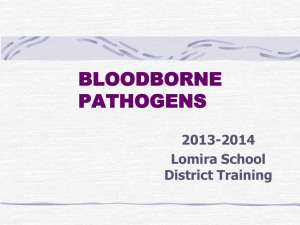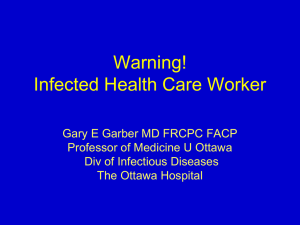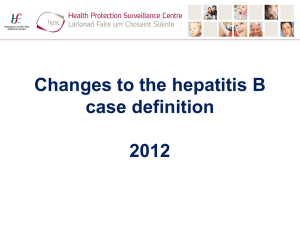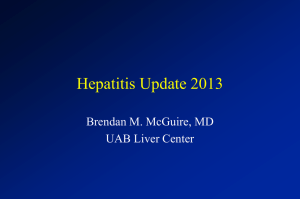Viral Hepatitis - Laboratory Diagnostics
advertisement
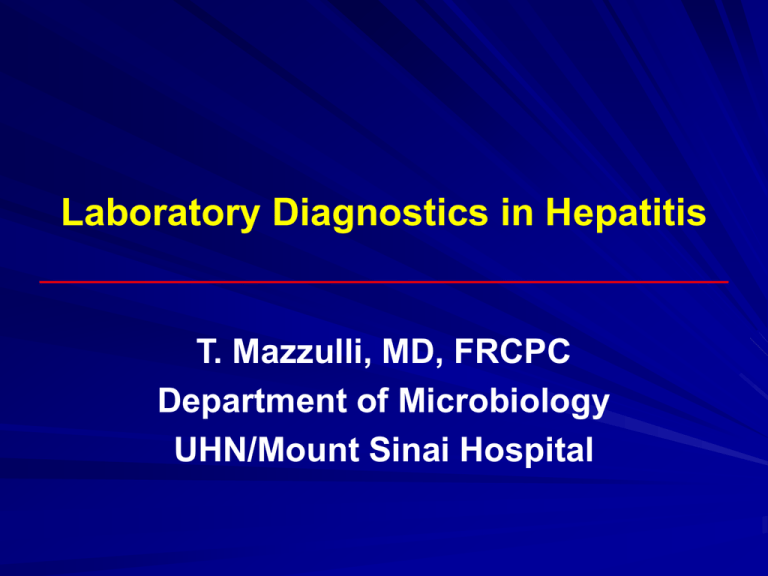
Laboratory Diagnostics in Hepatitis T. Mazzulli, MD, FRCPC Department of Microbiology UHN/Mount Sinai Hospital Objectives Review the serologic diagnosis of viral hepatitis Review the methodologies available for molecular testing and describe some of the advantages and disadvantages Discuss the currently available commercial assays that are available and those which are in use in Toronto Discuss the use of molecular methods for genotyping and resistance testing Hepatitis A - Diagnosis Three serologic markers available: 1. Hepatitis A Total (IgG and IgM) antibody 2. Hepatitis A IgM 3. Hepatitis A IgG First tests available since 1978 No antigen test Antibody response is similar following vaccination or wild type infection Incubation time is 7 to 28 days Hepatitis A Virus Infection Typical Serologic Course Symptoms Total antiHAV Titer ALT Fecal HAV 0 1 IgM anti-HAV 2 4 5 6 3 Months after Exposure 1 2 2 4 Laboratory Tests for HBV Serology: – Many tests available – most common tests are Enzyme Immunoassays (EIAs, MEIAs) – First tests available in 1972 – For every rule, there is an exception/caveat – No single test tells you everything Molecular: – HBV DNA (quantitative) – HBV genotyping – HBV resistance testing Hepatitis B – Laboratory Tests Serologic markers: 1) HBsAg (Hepatitis B surface antigen): • if positive, person is infectious • Sensitivity = 0.15 ng/ml • Specificity = 99.5% 2) Anti-HBs (Antibody to HBV surface antigen): • indicates immunity to HBV and protection from disease • Protective level is >10 IU/ml Hepatitis B – Laboratory Tests Serologic markers: 3) Anti - HBc (Antibody to HBV core antigen): • Total - indicates past or active infection; present whether person is immune or chronic carrier • Specificity = 99.8% to 99.9% • IgM - early indicator of acute infection • No antigen test Hepatitis B – Laboratory Tests Serologic markers: 4) HBeAg (Hepatitis Be antigen): • indicates person is highly infectious • Selecting patients for therapy 5) Anti-HBe (Antibody to HBVe antigen): • prognostic for resolution of infection; less infectious; spontaneous seroconversion in 10 to 20% of healthy adults per year Acute Hepatitis B Virus Infection with Recovery Typical Serologic Course Symptoms HBeAg anti-HBe Total anti-HBc Titer HBsAg 0 4 8 anti-HBs IgM anti-HBc 12 16 20 24 28 32 36 Weeks after Exposure 52 100 Progression to Chronic Hepatitis B Virus Typical Serologic Course Acute (6 months) Chronic (Years) HBeAg anti-HBe HBsAg Total antiHBc Titer IgM anti-HBc 0 4 8 12 16 20 24 28 32 36 52 Weeks after Exposure Years Virological and Biochemical Course of Chronic Hepatitis B Disease Phases in Chronic HBV Infection Phase HBsAg HBeAg AntiHBe ALT HBV DNA range Immune Tolerant + + - Normal >8 log IU/mL Immune Clearance + + - Normal or elevated 3-8 log IU/mL Inactive Disease + - + Normal <3 log IU/mL HBeAgnegative Chronic HBV + - + Normal or elevated 3-8 log IU/mL Interpretation of Serologic Tests in Hepatitis B Hepatitis B – Laboratory Tests Serologic markers – caveats: Persistent HBsAg for >6 mos = chronic infection HBsAg and anti-HBs may co-exist in up to 24% of chronically infected individuals; likely due to mutations in the “a” determinant of the S gene – Surface antigen escape mutants described in infants infected with HBV after HBIG + vaccination and in Liver transplants after prolonged HBIG Anti-HBc IgM may persist for up to 2 years in 20%; chronically infected individuals may have low titres which rise during acute flares Hepatitis B – Laboratory Tests Serologic markers – caveats: Precore or HBeAg negative mutants: – Due to mutation in precore (abolishes HBeAg production) or core promoter region (downregulates HBeAg production) – No effect on viral replication (may be enhanced) – More difficult to treat; greater risk of cirrhosis Co-infection with HCV may suppress both HBeAg and HBsAg HBV Viral Genome Organization HBcAg Hepatocyte receptor bindng site HBeAg Protein that transactivates transcriptional promotors HBsAg 3200 Base Pair Genome HBV DNA Polymerase Hepatitis B – Laboratory Tests Serologic markers – caveats: Isolated HBcAb may be due to: – Remote infection (immune or chronic carrier) – “Window” period between HBsAg and HBsAb – Co-infection with HCV – False positive test result – HBcAb is marker most prone to false positives HBV DNA may help sort this out Laboratory Tests for HCV Serology: Detection of anti-HCV antibodies Serologic test available since 1990 Molecular: HCV RNA detection Determination of HCV genotype Viral load determination Laboratory Tests for HCV Serology: Screening: – 3rd generation EIAs measure antibodies directed against recombinant peptides NS4, core, NS3, and NS5 proteins – Sensitivity = 97% – Detects antibodies within 6 to 8 weeks – No HCV IgM test available Confirmatory/supplementary: – RIBA, LiPA, Second EIA, HCV RNA Serologic Pattern of Acute HCV Infection with Progression to Chronic Infection antiHCV Symptoms +/- Titer HCV RNA ALT Normal 0 1 2 3 4 Months 5 6 1 2 3 Years Time after Exposure 4 Rational Use of HCV Diagnostic Tests TREATMENT Diagnosis Prognosis Serological assays Qual HCV RNA Liver histology Decision to treat Treatment duration ALT Liver histology Qual HCV RNA Genotyping Viral load Response and resistance assessment Qual HCV RNA Viral load Hepatitis D Virus - Diagnosis • Anti-HDV Total (IgG & IgM) available • Incubation time – similar to Hepatitis B • High titres of HDV antibodies indicate ongoing chronic infection • Available only at National Microbiology Lab in Winnipeg Hepatitis E Virus - Diagnosis • Both IgG and IgM antibody tests are available • Incubation period – 7 to 28 days • No domestically acquired cases in Canada • Available only at the National Microbiology Lab in Winnipeg Molecular Tests for Hepatitis Hepatitis Virus – Molecular Tests Molecular assays available as follows: – Commercial assays for HBV DNA and HCV RNA – In-house assays for HAV RNA & HDV RNA – No molecular assay for HEV RNA HCV RNA & HBV DNA, plasma or serum must be separated from cells within 6 hrs and plasma can be stored at 4oC for several days or -70oC for long-term No licensed tests for diagnostic purposes; all tests are for monitoring or donor screening – HCV RNA will be done in HIV or other immunocompromised patients if requested Hepatitis Virus – Molecular Tests Lower limit of Detection (LLD) does not equal dynamic (linear) range of quantitative assays – Determined by PROBIT analysis to determine the value that is consistently detected 95% of the time Results of different assays may (HBV) or may not (HCV) be interchangeable Nucleic Acid Amplification Tests (NAAT) for Detection of RNA/DNA Quantitation of RNA or DNA may be reported as copies/ml or IU/ml Conversion factor for copies/ml to IU/ml is not the same for different assays measuring the same target or different targets – HBV DNA: 5.82 copies/IU – HCV RNA: PCR - 2.4 copies/IU; bDNA: 5.2 copies/IU Coefficient of variation (COV) may range from 15 to 50% HBV DNA Quantification Assays Assay Versant bDNA v3.0 (Siemens) Hybrid Capture II (Digene) Liquid Hybridization (Abbott) Cobas Amplicor Monitor (Roche) Sensitivity (pg/ml)* LLD (copies/ml)* 2.1 2 x 103 2 x 103 to 1 x 108 15 - 37% 0.02 to 0.5 5 x 103 5 x 103 to 6 x 107 10 – 15% 1.6 6 x 105 5 x 105 to 1 x 1010 12 – 22% 0.001 2 x 102 2 x 102 to 2 x 105 14 – 44% Cobas Taqman (Roche) RealArt HBV PCR (artus/Qiagen) *283,000 copies/pg; 5.26 copies/IU Linearity Coefficient (copies/ml) of Variation 35 (Manual) 2 x 102 to 1 x 1010 70 (Automated) 10 16 – 54% 1 to 4 x 108 A. Lok et al. Hepatology 2001;34; J. Servoss et al. Infect Dis Clin N Am 2006;20; B. Weber. Future Drugs 2005 Measuring HBV DNA Gish and Locarnini, Clin Gastro Hep 2006 Comparison of Quantitative HBV DNA Assays Versant 3.0 vs. Versant 1.0: R2 = 0.9001 Versant vs. Cobas: R2 = 0.7711 Versant vs. Digene: R2 = 0.9849 Yao J et al. J Clin Microbiol 2004:42(2) HCV RNA Detection Assays Assay Method LLD* (IU/ml)a Linearity (IU/ml) TMA 5 - 10 NA Amplicor Qualitative v2.0 (Roche) RT-PCR 50 NA Ampliscreen (Roche) RT-PCR 50 NA Amplicor Monitor v2.0 (Roche) RT-PCR 600 600-800,000 Cobas Taqman (Roche) RT-PCR 15 15 – 1 x 108 Abbott RealTime (Abbott) RT-PCR 12 - 30 10 – 1 x 107 Versant Quantitative v3.0 (Siemens) bDNA 615 615 7,700,000 Versant Qualitative (Siemens) *LLD = Lower Limit of Detection; aConversion factor IU/ml to copies/ml varies with each assay (e.g. PCR: 1 IU/ml = 2.4 copies/ml; bDNA: 1IU/ml = 5.2 copies/ml) S. Chevaliez et al. World J Gastro 2007;13; J Scott et al. JAMA 2007;297; A. Caliendo et al. J Clin Microbiol 2006;44 HBV DNA in Clinical Practice Routine monitoring on therapy to assess response to treatment – Every 3 months X years on oral agents – Every 1 month X 6-12 on PEG/IFN Routine monitoring off therapy to estimate prognosis and to evaluate need for treatment – Every 6 –12 months normally – Diagnosis of occult HBV infection Laboratory Tests for HCV Molecular: Both qualitative and quantitative HCV RNA assays available Used for treatment monitoring (and in some circumstances for confirmation of positive or indeterminate serology) HCV RNA is detectable 2 to 14 days after an exposure Ministry of Health and Long-Term Care Ministère de la Santé et des Soins de longue durée Laboratories Branch P.O. Box 9000, Terminal “A” (81 Resources Road, Etobicoke) Toronto, Ontario M5W 1R5 Direction des Laboratoires C.P. 9000, Terminal “A” (81 Chemin Resources, Etobicoke) Toronto (Ontario) M5W 1R5 Telephone: (416) 235-5737 Facsim ile: (416) 235-6197 Téléphone: (416) 235-5737 Télécopieur: (416) 235-6197 PHL LAB INFORMATION FORM FOR HEPATITIS C RNA AND HEPATITIS B VIRAL LOAD THIS IS NOT A DATA S HEET, please attach to PHL test requisition Minimum volume 2.5 mL serum, removed from clot within 4 hours and submitted frozen to the lab. PATIENT'S NAME: ___________________________________ PHL LAB#: _________________ DR’s NAME ______________________________ HEPATITIS C (HCV) RNA - QUANTITATIVE Baseline and Genotyping (Pre-Treatment) Quantitative Viral Load - Week 12 of treatment Quantitative Viral Load – due to change in treatment/dose ______ weeks HEPATITIS C (HCV) RNA - QUALITATIVE Query the presence of active HCV infection (HIV immunocompromised, infant of HCV positive mother, patient with anti HCV indeterminate result, 8-10 weeks post exposure, etc). Confirm successful treatment at 4 weeks (genotypes 2 and 3) On Treatment _________ weeks Post Treatment _________ weeks (2 samples less than the detection limit (<50 IU/mL) and 6 months apart are required to confirm successful treatment. No follow up required unless there is a new exposure). HEPATITIS B (HBV) VIRAL LOAD (NOTE: Test is not u seful for diagnosis. Research use only) Pre-Treatment for HBV On Treatment _________ weeks Post Treatment LFTs/Clinical Information: ALT ___________ AST __________ Genotyping Used for: – Detection of mutations that confer resistance to antiviral agents – Genotyping of isolates for epidemiological purposes; categorizes patient isolates into 8 different HBV genotypes (A to H) and 6 different HCV genotypes (1 to 6 with 24 subtypes) Methods include: – Sequencing – Hybridization (Line Probe Assay, Trugene Assay) Laboratory Diagnosis of Resistance Sequencing Line Probe Pros Cons Discovers Labor-intensive new mutations Low sensitivity (15-20% pop.) High throughput Detects known High sensitivity (5-10% pop.) mutations only InnoLiPA Principle Chromogen (NBT/BCIP) Marker line Conj.cont. Amp.cont. Purple precipitate Alkaline Phosphatase L180 Streptavidin M180 Biotin M204 V204 Amplified target I204 V207 L207 M207 I207 DNA-probe Nitrocellulose strip InnoLIPA HBV Drug Resistance M a r k e r lin e 1 - C o n j. C o n tr o l 2 - A m p .C o n t ro l 3 - L80 W T 4 - V 8 0 M u ta n t 5 - I 8 0 M u ta n t 6 - V173 W T 7 - G 173 W T 8 - L 1 7 3 M u ta n t 9 - L180 W T 10 - M 1 8 0 M u ta n t 11 - A181 W T 12 - T 1 8 1 M u ta n t 13 - V 1 8 1 M u ta n t 14 - M 204 W T 15 - V 2 0 4 M u ta n t 16 - I 2 0 4 M u ta n t 17 - S 2 0 4 M u ta n t 18 - N 236 W T 19 - T 2 3 6 M u ta n t HBV Resistance Testing HBV Resistance Testing InnoLiPA vs. Sequencing Hussein et al, J Clin Micro 2006 Drug Resistance Report LAMIVUDINE Present Mixed L80V V173L Absent X X L180M X M204V X M204I X M204S X ADEFOVIR Present Mixed Absent A181V X A181T X N236T X Interpreting HBV DR Reports Resistance Mutation Sensitive Resistant or Reduced Susceptibility Lamivudine Resistance Adefovir Resistance Adefovir Resistance L180M +M204V N236T A181V/T Adefovir Tenofovir Lamivudine Entecavir Telbivudine Emtricitabine Lamivudine Tenofovir Entecavir Emtricitabine Lamivudine Entecavir Telbivudine Emtricitabine Clevudine Adefovir Tenofovir Clevudine Adefovir L180M + M204V/I are the key lamivudine-resistant mutations A181V/T leads to 4-fold increase in IC50 N236T leads to 7-fold increase in IC50 Diagnostics in Viral Hepatitis: Summary Serology remains the cornerstone for diagnosis and screening NAAT is critical to patient management Of the many NAAT tests available, PCR, bDNA and TMA remain most popular – Sensitivity and dynamic range varies between assays – Standardization allows (to some degree) interchangeability of the results with different assays Resistance/Genotyping requires amplification first – Increasing role in making treatment decisions as more drugs become available for HBV
